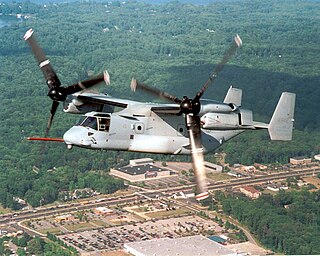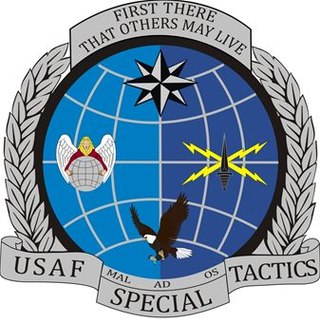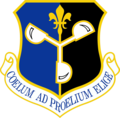United States special operations forces (SOF) are the active and reserve component forces of the United States Army, Marine Corps, Navy and Air Force within the US military, as designated by the Secretary of Defense and specifically organized, trained, and equipped to conduct and support special operations. All active and reserve special operations forces are assigned to the United States Special Operations Command (USSOCOM).

Air Force Special Operations Command (AFSOC), headquartered at Hurlburt Field, Florida, is the special operations component of the United States Air Force. An Air Force major command (MAJCOM), AFSOC is also the U.S. Air Force component command to United States Special Operations Command (USSOCOM), a unified combatant command located at MacDill Air Force Base, Florida. AFSOC provides all Air Force Special Operations Forces (SOF) for worldwide deployment and assignment to regional unified combatant commands.

The 353rd Special Operations Wing is an operational unit of the United States Air Force Special Operations Command, stationed at Kadena Air Base, Japan.

The 321st Special Tactics Squadron is an active ground unit, within the 752d Special Operations Group, United States Air Force, United States European Command, and is based at RAF Mildenhall, in Suffolk, eastern England.

The 24th Special Tactics Squadron is one of the Special Tactics units of the United States Air Force Special Operations Command (AFSOC). Garrisoned at Pope Field, North Carolina, it is the U.S. Air Force component of Joint Special Operations Command (JSOC). The unit's webpage describes it as "the Air Force's special operations ground force".

The 1st Special Operations Wing at Hurlburt Field, Florida is one of three United States Air Force active duty Special Operations wings and falls under the Air Force Special Operations Command (AFSOC).

The 24th Special Operations Wing is a United States Air Force active-duty wing that was activated on 12 June 2012. Its headquarters is at Hurlburt Field, Florida and it has component groups located in North Carolina, Georgia and Washington. It is the third special operations wing in Air Force Special Operations Command (AFSOC).

The 18th Special Operations Test and Evaluation Squadron is an active unit of the United States Air Force, based at Hurlburt Field, Florida. The squadron performs field testing for Air Force Special Operations Command, evaluating aircraft, equipment, and tactics in realistic battlespace environments to provide decision-makers with accurate, timely, and complete assessments of mission capability. From concept development to system fielding, the unit's mission improves the survivability and combat capability of special operations forces worldwide.

The 6th Special Operations Squadron is part of the 27th Special Operations Wing at Cannon Air Force Base, New Mexico. The squadron operates MC-130J Commando II aircraft in support of special operations. The 6th SOS specializes in the use of night vision goggles and formation tactics to refuel large helicopter and tilt-rotor formations.

The United States Air Force Combat Control Teams, singular Combat Controller (CCT), are an elite special operations force who specialize in all aspects of air-ground communication, as well as air traffic control, fire support, and command, control, and communications in covert, forward, or austere environments.

The 23rd Special Tactics Squadron is an active ground unit, within the 24th Special Operations Wing United States Air Force Special Operations Command (AFSOC). It is garrisoned at Hurlburt Field, Florida. The 23rd STS was previously designated the 1723rd Special Tactics Squadron prior to 1992.

The 3rd Special Operations Squadron flies MQ-9 Reaper Remotely Piloted Aircraft and is currently located at Cannon Air Force Base, New Mexico. The squadron is under the command of the Air Force Special Operations Command.

The United States Air Force Special Operations Training Center (AFSOTC) was located at Hurlburt Field, Florida. It worked under the supervision of the Air Force Special Operations Command (AFSOC); Its primary function was to train the Air Force's Special Operations Personnel before being assigned to their respective units. The Mission Statement/Vision was, "Transforming Airmen into Air Commandos who possess the specialized skills and warrior ethos to fight and win anytime, anywhere." The AFSOTC was replaced 11 February 2013 by the Air Force Special Operations Air Warfare Center.

A United States Air Force Tactical Air Control Party, commonly abbreviated TACP, is an individual or team of United States Air Force Special Warfare Airmen with AFSC 1Z3X1, who are aligned with conventional, Special Operation Forces, and Tier 1 combat maneuver units. They provide precision terminal attack control and terminal attack guidance of U.S. and coalition fixed- and rotary-wing close air support aircraft, artillery, and naval gunfire; establish and maintain command and control (C2) communications; and advise ground commanders on the best use of air power.

Lieutenant General Eric E. Fiel is a retired United States Air Force officer who served as commander of Air Force Special Operations Command from 2011 to 2014. The command is the Air Force component of United States Special Operations Command. AFSOC provides Air Force special operations forces for worldwide deployment and assignment to unified combatant commanders. The command has approximately 16,000 active-duty, Reserve, Air National Guard and civilian professionals.

The 720th Special Tactics Group is one of the special operations ground components of the 24th Special Operations Wing, assigned to Air Force Special Operations Command (AFSOC) of the United States Air Force. The group is headquartered at Hurlburt Field, Florida. The group is composed of geographically separated squadrons in four separate states; Florida, New Mexico, North Carolina and Washington.

A United States Air Force Special Tactics Officer is a United States Air Force Special Operations Command (AFSOC) Special Warfare Officer who manages the training and equipping of U.S. Air Force ground special operations. Special Tactics Officers deploy as team leaders or mission commanders in combat, seizing and controlling airstrips, combat search and rescue, guiding airstrikes and fire support using air assets for special operations and tactical weather observations and forecasting. Special Tactics Officers are not Pararescuemen, Combat Controllers, or Special Reconnaissance, but they lead the Special Tactics Squadrons and Groups and thoroughly understand how to conduct, manage, and provide these special operations missions to both conventional and joint special operations missions needed within Joint Special Operations Command (JSOC) and United States Special Operations Command (SOCOM).
The United States Air Force Special Operations Air Warfare Center (AFSOAWC) is headquartered at Hurlburt Field, FL, with satellite locations at Duke Field, FL, and Robins AFB, GA. It works under the supervision of the Air Force Special Operations Command (AFSOC); Its primary function is to organize, train, educate and equip forces to conduct special operations missions; lead MAJCOM Irregular Warfare activities; execute special operations test and evaluation and lessons learned programs; and develop doctrine, tactics, techniques and procedures for Air Force Special Operations Forces. The Vision is, "Transforming Airmen into Air Commandos who possess the specialized skills and warrior ethos to fight and win anytime, anywhere."

The 724th Special Tactics Group is one of the special operations ground components of the 24th Special Operations Wing, assigned to Air Force Special Operations Command (AFSOC). The Group is headquartered at Pope Field, North Carolina. The Group is composed of four squadrons, also located on Pope Field.

The 320th Special Tactics Squadron is a Special Tactics unit of the United States Air Force Special Operations Command, based at Kadena Air Base.
























